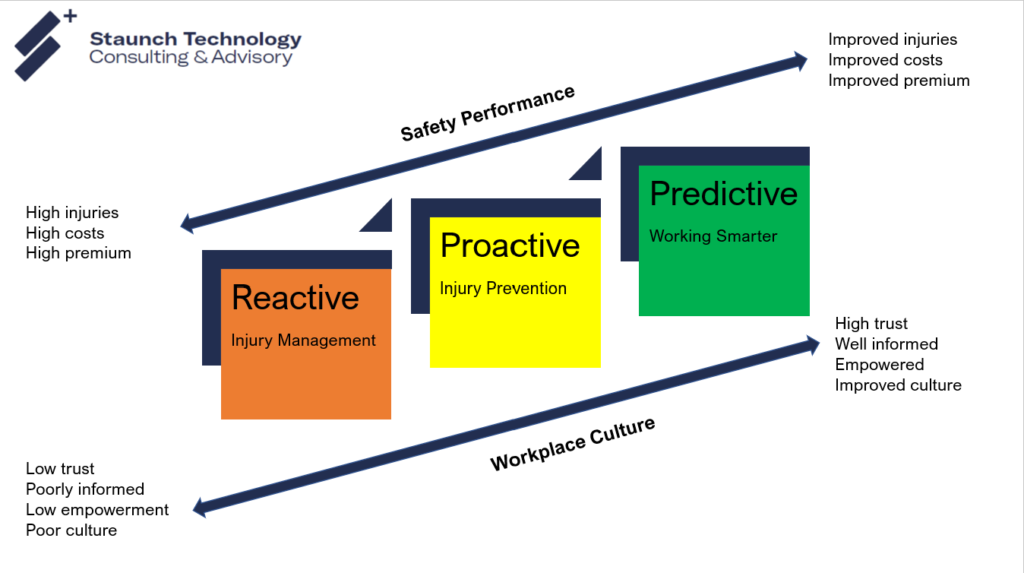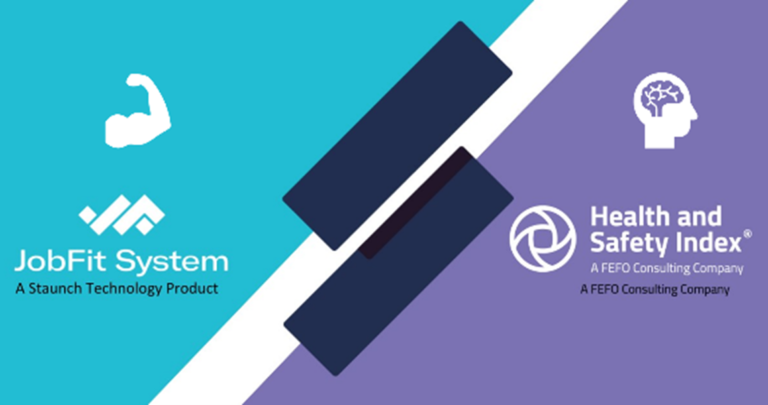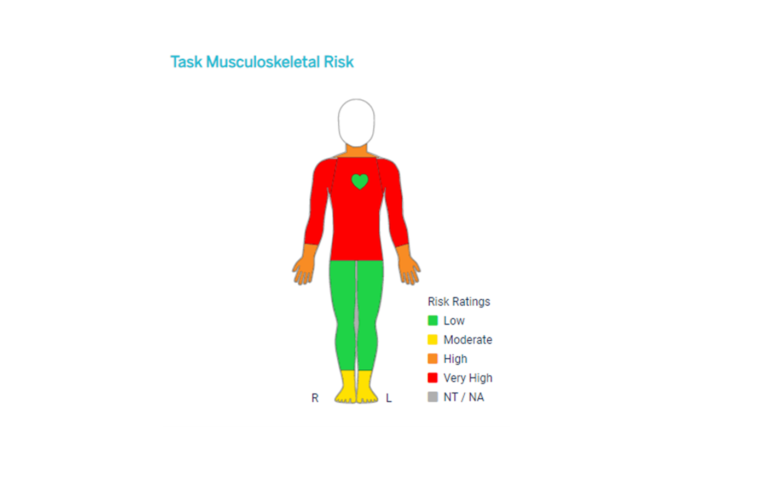Written by Dr Jenny Legge, Founder and CEO, Staunch Technology

When is a Trifecta, not a good trifecta? When you operate in the production economy, in a country with a labour shortage and a working population that is ageing. Does this sound familiar? You know what you need to do to prevent an injury, but you have limited budget, resources or influence to make equipment and process improvements, your employer is pressuring you to fill a role and you long for the days when you had more choice.
Read on to learn how to flip this situation into a winning one – by measuring what matters to understand the benefits and logical steps to manage the risks of sprains and strains in your industry, in our economy at this time. A productive, healthy, and happy workforce is achievable.
To understand where you need to get to, you must understand where you are now

How an organisation manages their injury risk can be viewed across a continuum, from those who are reactive in their methods, through to those who work smarter and take a data-driven predictive approach.
Organisations with poor work design have poorer safety performance – reflected in high injuries, high costs and high Workers Comp premiums; magnified by a poorer workplace culture with feelings of low trust, employees feeling poorly informed, with low empowerment and morale. At the other end of the continuum, organisations implementing good work design benefit from improved injury rates, lower costs, and better insurance premiums. Their people feel higher levels of trust, feel informed, and empowered – resulting in a better workplace culture.
Our industry experience tells us that the journey toward a predictive model of workplace health often isn’t easy, particularly over a sustained period. Current workforce factors, including the national labour shortage and our ageing workforce are challenging organisations’ maturity along this journey – but with a data-driven approach they can move forward towards being a predictive high performing workplace.
Completing an honest, self-assessment to identify where you and your organisation are placed on this journey, including the exposure to the current risks to your workforce, will give you insight into your vulnerability and idea of where to start to reduce this. We’ve developed an online vulnerability assessment which you can quickly complete here.
We’re all in the same risk-exposure boat
Irrespective of which point on the injury risk management continuum you’re at, unfortunately there are some factors in the labour landscape that we can’t run away from.
Labour shortage
What is a labour and skills shortage? Quite simply, a labour shortage is when an employer finds it very difficult, or unable, to fill a position irrespective of skills requirements. A skills shortage is when applicants can’t meet the specialised skills needed (within current remuneration or other work conditions on offer, such as preferred working location). The labour market has been tight for a few decades, but COVID-19 certainly exacerbated that. The ABS reports unemployment, currently at 3.5%, is still hovering around the record low of the last 50 years of 3.4% seen in July 2022. This is despite one of the highest ever employment to population ratios of 64.4%. These challenges are further exacerbated by increase in consumer demand of 42%.
We’re all sick of talking about it, but we can’t deny COVID-19s’ impact here. It reduced access to workers from closing international and domestic borders, and then further isolated us at home. This restriction in access to workers particularly affected agriculture, hospitality, and health. Then the stimulus packages increased demand for workers in retail but also tradespersons. Lower paid industries like construction were then losing out to higher wages in mining and infrastructure projects. And then the professional services sector quite simply got burnt out, resulting in health and aged care workers and educators just leaving.
Ageing workforce
Older workers have higher injury rates and take longer to recover. When we think about our ageing workforce, most employers think about ‘their’ workforce and consider a solution to lowering their average employee age is to recruit younger workers. But our demographics are changing. ‘THE’ workforce is ageing, which means that the recruitment pool is also ageing, and fewer younger workers are entering the workforce, particularly in the production economy. Employers operating in a predictive model take a longer-term view of their workforce health, maximise the benefits of an experienced workforce and design for good health of an ageing workforce.
Setting up for a healthy, happy, and productive workforce

Understanding what you may be up against when it comes to injury risk can be confronting, but a step towards being predictive is being proactive, which you and your organisation can do by instilling Good Work Design principles. These principles were established to support the Australian Work Health & Safety Strategy (2012-2022) for “Healthy, Safe and Productive Working Lives.” Good work design considers work tasks, activities, relationships, and responsibilities, and has numerous benefits:
- Good Work Design enhances health and well-being, employee engagement and performance.
- Good Work Design enhances business success and productivity, the utilisation of skills and efficiency of performance
- And to meet your legal obligations, Good Work Design gives the highest level of protection so far as it reasonably practical
There are ten ‘Good Work Design’ principles supporting health and safety at work and business productivity – below are some initial ideas for implementing these principles to manage your injury risk during a labour shortage with an ageing workforce.
Job Design
- Prioritize essential tasks so workers are not overburdened with lower priority ones
- Be sure to group tasks together to form a meaningful job
- Clarify processes and expectations to promote autonomy and remove bottlenecks
Automation and process change
- Automate repetitive or physically demanding tasks
- Measure job demands, and injury risk factors to redesign equipment and processes for reducing load
Multi-skilling and resilience
- Cross train workers for flexibility and resilience
- Alternate cognitive and / or physical demands
- Measure individual risk and implement prehab
Flexible work practice
- Consider flexibility for where, when, and how
- Provide opportunities for social contact
A productive, healthy, and happy workforce is achievable. Find out how by joining Dr. Jenny Legge’s presentation at the Brisbane WHS Show Spotlight Stage (1pm 31st May) and visiting their team of Good Work Design experts at Staunch Technology D27 over the show’s two days or visit staunch.io.










